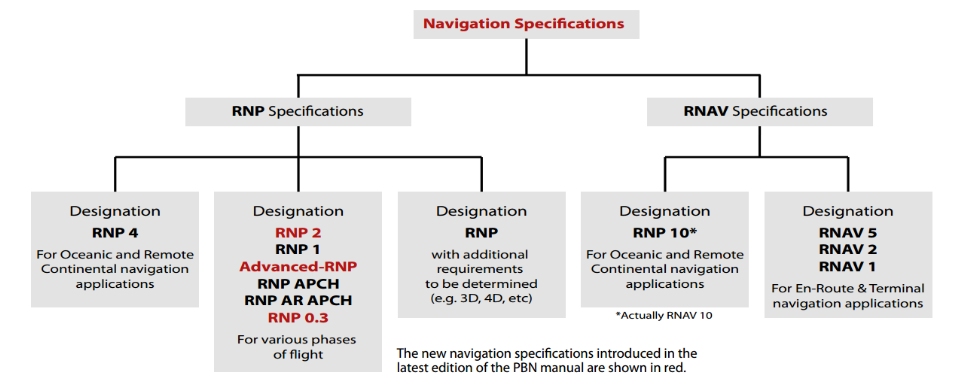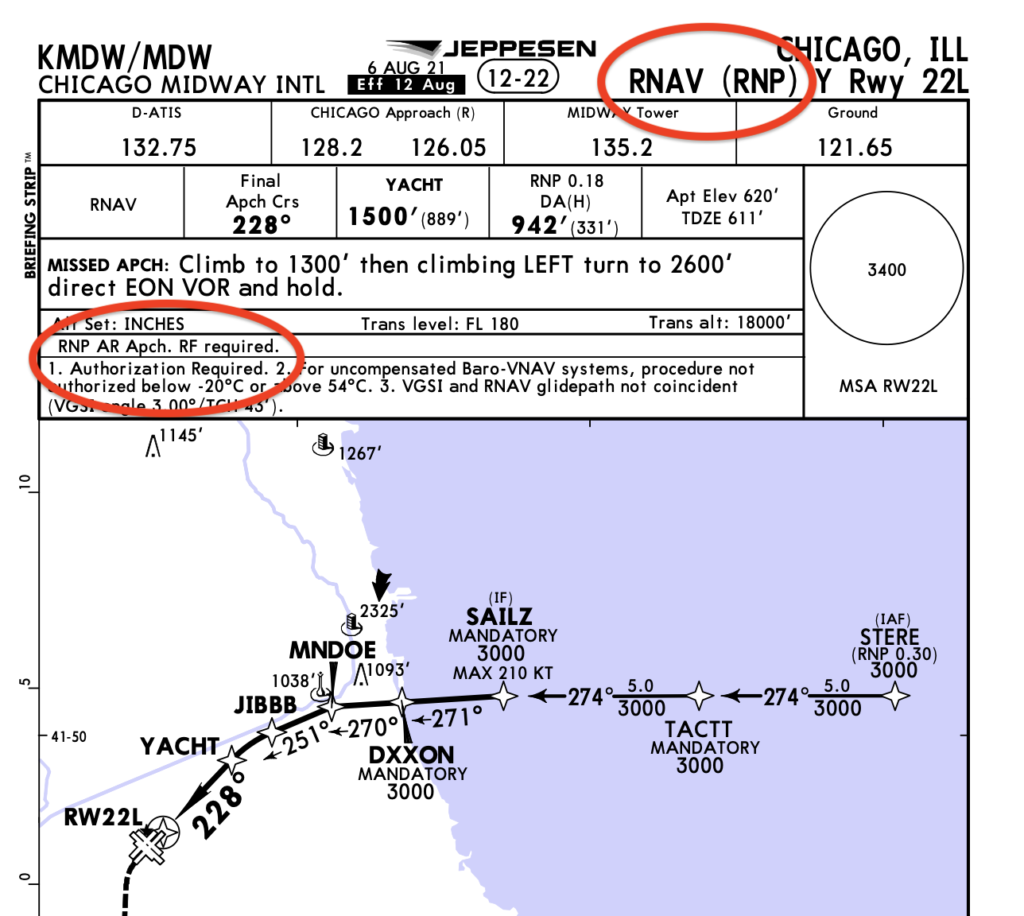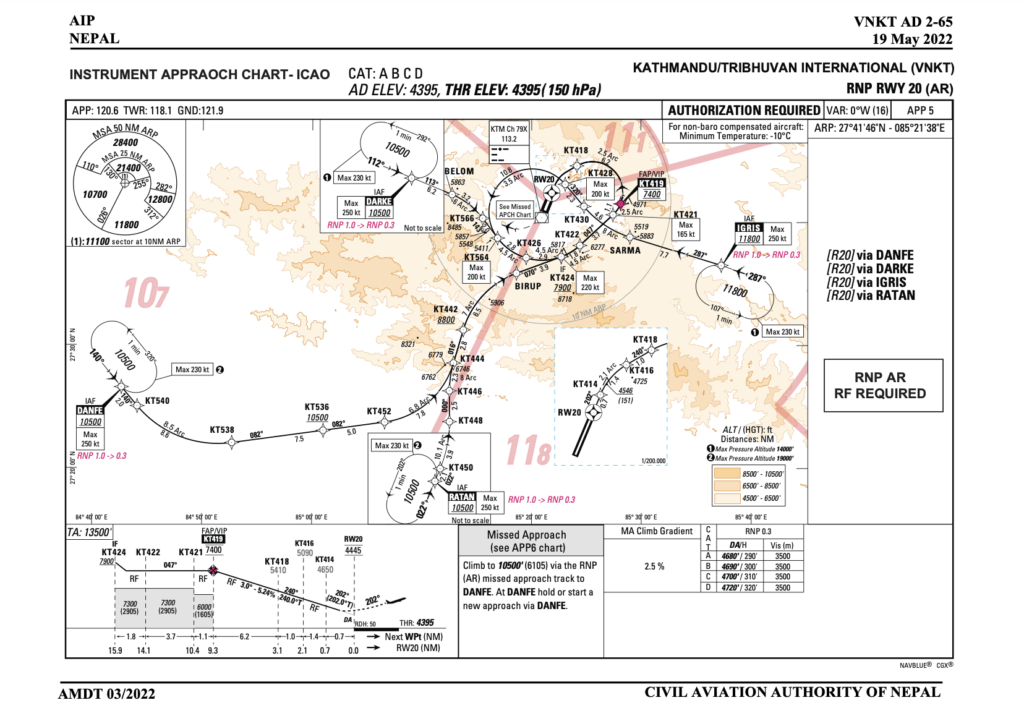RNP AR approaches are not your standard stuff. They need special authorisation and training for you to fly them. But it is worth it because these complex looking approaches are generally used in some of the most challenging places, to make your life easier (and safer).
So here is a quick look at them, some insights into why you might want to fly them, and how to sort that out.
What does this acronym mean then?
RNP means Required Navigation Performance. Which is something under the whole ‘PBN’ thing which basically lets aircraft fly along a nice, precise path with a lot of accuracy.
It’s the newer, better version of RNAV that has performance monitoring and alerting involved.
You’ve probably come across it in a bunch of different places and with different numbers after it. RNP 4 over the oceanic and remote spots, RNP 1 on approaches… the number is the accuracy requirement. So 4 means accurate to 4nm 95% of the time. Or your system tells you (that’s the alerting bit).
AR means authorisation required.

A lifeless-but-otherwise-perfectly-functional table to show PBN performance specs.
RNP-AR you allowed?
You can get that authorisation with an LOA and a bunch of training. In the US this is covered under section 9 of your En-Route / General Rules and Procedures / Holding, Approach and Departure Procedures which you can find here.
The FAA issues RNP AR authorization via operations specification (OpSpec), management specification (Mspec), or letter of authorization (LOA C384). There are no exceptions. Operators can find a lot of info on RNP AR aircraft eligibility, operating procedures, and training requirements in AC 90-101.
Which (because we’re generous with our links) can be read here.
Like anything, it comes down to the equipment you have in your aircraft as well. It requires certain GNSS and an on-board inertial system (IRU/IRS) setup, an FMS navigation with multi-sensor capability (so there is something as a backup to maintain RNP if the GNSS is lost)…
Surprisingly few BizJets seem to have what is needed. Good news though, companies do offer retrofit options.
So, what does an RNP AR look like?
Well, it should look accurate to 0.3 (that’s about 40m with SBAS), and sometimes even 0.1.
If you’re in the US then your RNP AR APCH is probably going to be called an RNAV (RNP). It should have AUTHORISATION REQUIRED scribbled somewhere on the chart too because, you know, you need it…

What it is and what you need.
You do also get ones for departures too.
Why do we like them?
“An RNP AR APCH (approach) is a procedure that allows for narrow, linear obstacle clearance corridors in the procedure design…”
In other words they help you get into tough places by giving more guidance in a more sort of 3D way.
This means they can have some real funky stuff going on in them like swirly turns, RF (radius-to-fixes) and all that sort of stuff. But if you know how to fly them and are allowed to then this is going to save you a whole bunch of woe in some challenging spots.
Like VNKT/Kathmandu…

A particularly swirly one
Kathmandu?
Yep, Nepal’s main international airport. (They only just built their second international airport in April 2022 over at Bhairahawa).
At VNKT/Kathmandu, they just installed some RNP AR approaches which came into effect May 19. And about time too, because this is a mean airport with all that terrain, and before these new approaches you just had some VORs.
You can find the full AIP here.
If they remind you of that old snake game then that’s because there is a lot of vicious terrain in Kathmandu. Which is why RNP AR approaches which let you zigzag between all the mountainy bits are helpful.

Where else are these handy?
Anywhere there is nasty terrain. Alaska, New Zealand, Peru, Chile, Ecuador, Indonesia… There is one for Cape Town that massively reduces track miles, another in Guatemala for departure that will help with your payload restrictions…
KPSP/Palm Springs makes excellent use of them, and you will even find them at some major airports which don’t have terrain, because they can ensure traffic remains clear of other airports in particularly congested airspace (KMDW/Midway and KORD/O’Hare for example).
Want more info?
This is a good article from AvBuyer which goes into more depth for those of you looking to retrofit your aircraft.
Here is a presentation from ICAO on it, because who doesn’t love a good powerpoint.
More on the topic:
- More: LOA Guide for US Operators
- More: RNP-AR: New Arrival Procedures at Toronto
- More: US LOAs: What’s the point of the C052?
- More: LOAs: Got Your Number?
- More: Regulatory deadlines on the horizon
More reading:
- Latest: Crossing the Quiet South: From Australia to Argentina
- Latest: Major runway shutdowns ahead at KVNY/Van Nuys
- Latest: New FAA Airspace Warnings for Venezuela and Puerto Rico
- Safe Airspace: Risk Database
- Weekly Ops Bulletin: Subscribe
- Membership plans: Why join OPSGROUP?











 Get the famous weekly
Get the famous weekly 






I like our fun and demystifying way of writing, good job!